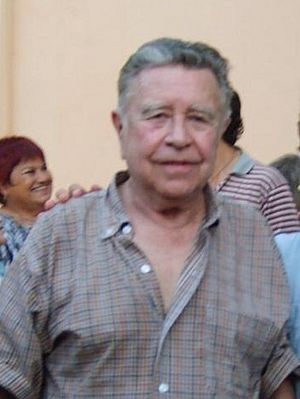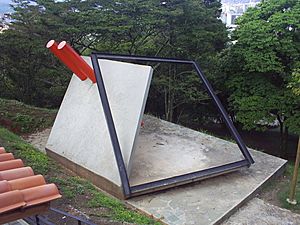Manuel Felguérez facts for kids
Quick facts for kids
Manuel Felguérez
|
|
|---|---|

Felguérez in 2008
|
|
| Born |
Manuel Felguérez Barra
December 12, 1928 Valparaíso, Zacatecas, Mexico
|
| Died | June 8, 2020 (aged 91) Zacatecas, Mexico
|
| Education | Académie de la Grande Chaumière |
| Known for | Abstract art |
| Movement | Generación de la Ruptura |
| Spouse(s) |
Ruth Rohde
(m. 1951; div. 1959)Mercedes Oteyza
(m. 1974) |
Manuel Felguérez Barra (born December 12, 1928 – died June 8, 2020) was a famous Mexican artist. He created abstract art, which uses shapes, colors, and lines instead of realistic images. Manuel was part of a group called the Generación de la Ruptura (Generation of the Break). This group changed Mexican art in the mid-20th century. They moved away from the traditional mural paintings of artists like Diego Rivera.
Contents
Manuel Felguérez: Early Life and Art Journey
Manuel Felguérez was born in Valparaíso, Zacatecas, Mexico, on December 12, 1928. His family owned a large farm called a hacienda. However, Mexico was going through a tough time with a conflict called the Cristero War. This war was about religion and land. Because of this fighting, his family lost their land. They had to move to Mexico City in 1934. Manuel's father passed away a year later when Manuel was only eight years old.
Manuel grew up with his mother and her family in Mexico City. He was a Boy Scout from age eight to twenty-three. Being a Scout allowed him to travel to Europe in 1947, right after World War II. He was amazed by the art he saw there, especially the paintings of William Turner. This trip made him decide to become an artist.
Learning to Be an Artist
When he returned to Mexico, Manuel tried studying at the Academy of San Carlos. But he didn't like its old-fashioned teaching style. So, he went back to Europe to study art in Paris. He learned at the Académie de la Grande Chaumière with a famous artist named Ossip Zadkine. Zadkine became his teacher and guide.
Manuel returned to Mexico in 1950. He continued his studies, learning about anthropology (the study of human societies) and history. He also took modern art classes. In 1951, he met his first wife, Ruth Rohde. They had two children. Later, he married artist Lilia Carrillo in 1959. After she passed away in 1974, he married Mercedes Oteyza.
Besides being an artist, Manuel also worked as a teacher for thirty years. He taught at the Ibero-American University and the National Autonomous University of Mexico. He believed it was important to teach students to be original and create new things. Manuel Felguérez continued to create art until he was very old. He passed away on June 8, 2020, at the age of 91, from COVID-19.
Manuel Felguérez: Art Career and Style
Manuel Felguérez had a long and busy career. He created paintings, sculptures, and even designed for theater and movies. He had over 250 solo art shows and participated in more than 1,500 group exhibitions. He felt his most important works were his "sculpted murals" and public sculptures. These were large art pieces made from materials like metal scraps, stones, and sand. He made many of these in the early part of his career.
Manuel was a key member of the Generación de la Ruptura. This group of artists wanted to break away from the traditional art styles in Mexico. They explored more abstract art, which was new and sometimes not accepted at first. In the 1950s and 1960s, abstract art was not popular with some art institutions. So, Manuel mostly showed his art in private galleries.
Important Exhibitions and Public Art
His first art show was in 1954. It was very successful, and he sold all his artwork. This helped him get a scholarship to study in France again. Throughout his career, his art was shown in major exhibitions around the world. These included shows in Paris, São Paulo, Tokyo, and New York.
Even in his eighties, Manuel Felguérez continued to create new art. In 2009, a big exhibition of his work, "Manuel Felguérez, Invención Constructiva," was held at the Palacio de Bellas Artes in Mexico City. For Mexico's 200th Independence celebration in 2010, his large mural "Ecuación en Acero" (Equation in Steel) was unveiled. His art is still shown today, and you can find his works in various places, including a hotel in Colorado.
Manuel spent many hours each day working on his art. He also started using computers to design his pieces, exploring new ways to create.
Manuel Felguérez: Digital Art Pioneer
Manuel Felguérez was one of the first artists in Mexico to use computers in his art. He started experimenting with computers in the 1970s.
The Multiple Space (1973)
Manuel called one of his early computer projects "The Multiple Space." He saw it as a way to create "pre-sculptures" or systems of symbols. He used computers to explore how shapes and patterns could be created and changed. He even wrote a book about his experiments, which made him a pioneer in digital art in Mexico.
The Aesthetic Machine (1975)
Another project was "The Aesthetic Machine." For this, Manuel used computers to help him design sculptures and paintings. He would give the computer certain rules about shapes, sizes, and colors. Then, the computer would generate many different possible art compositions. This project showed how artists and computers could work together to create new forms of art. Manuel believed that computers could speed up the creative process.
Manuel Felguérez: Artistic Style and Ideas
Manuel Felguérez's art style was shaped by different art movements he saw in Europe. He combined ideas from geometric-constructivist art and abstract expressionism. His works often use basic geometric shapes like circles, triangles, and squares. He put these shapes together to create his own unique artistic "language." Some art experts have compared his work to that of famous artists like Picasso and Rufino Tamayo.
Manuel believed that art should be about life, not death. He focused on making beautiful art that looked good, rather than showing his emotions. He once said he was a "producer and seller of aesthetic pleasure."
He loved to experiment and try new things. He felt that constant change and evolution are what make an artist different from someone who just repeats the same styles. He didn't want to create a new "school" of art because he believed in always moving forward and creating something new. His later work, especially from the mid-1970s, showed how he used computers to explore geometric shapes even more.
Manuel Felguérez: Awards and Recognition
Manuel Felguérez received many important awards and honors for his contributions to art:
- In 1973, he became a member of Mexico's Academia de Artes.
- In 1975, he received a Guggenheim fellowship, which is a special grant for artists. He also won the Gran Premio de Honor at the XIII Bienal de São Paulo in Brazil.
- In 1987, his home state of Zacatecas named him an "illustrious citizen."
- In 1988, he received the Premio Nacional de Artes, one of Mexico's highest awards for artists.
- In 1993, he was named a "Creator Emeritus" by the president of Mexico.
- He also received an honorary doctorate degree from the Universidad Autónoma Metropolitana.
Manuel Felguérez Abstract Art Museum
The Manuel Felguérez Abstract Art Museum opened in 1998 in the city of Zacatecas. The museum is in a beautiful old building from the 1800s that used to be a seminary and then a jail.
The museum's main collection has about 100 of Manuel Felguérez's own artworks. These pieces show how his art changed and grew over his long career. The museum also has more than 110 works by other Mexican and international abstract artists. Manuel donated his personal art collection to the museum. He wanted it to be a place dedicated to abstract art from his generation and beyond.
See also
 In Spanish: Manuel Felguérez para niños
In Spanish: Manuel Felguérez para niños



